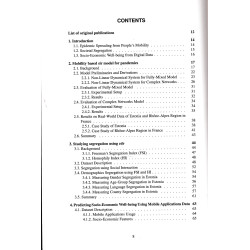





Rahul Goel
Tartu : Tartu Ülikooli Kirjastus, 2023
103 p. : ill.
ISBN: 9789916272473
Dissertationes informaticae Universitatis Tartuensis, 2613-5906 ; 42
Paperback dissertation in very good condition.
Mobile data such as call data records (CDR), and digital data generate a large volume of data that carries valuable information about people’s behavior. In this thesis, we focus on three facets of societal well-being. First, we propose two versions of the mobility-based SIR model, (i) fully-mixed and (ii) for complex networks, which take into account real-life interactions from CDR. This work is inspired by the assumption that the fundamental cause for some epidemics becoming pandemics is global connectedness, which makes it easier to affect a larger geographical area, often globally. Furthermore, population distribution, people’s mobility, and social coherence are not uniform across the globe which plays a critical role. We also used our model to forecast the COVID-19 cases for Estonia and Rhône-Alpes region in France.
Second, we study societal segregation in Estonia using CDR data. Our findings suggest that (i) gender segregation exists in Estonia and its traces are visible in individuals calling hours, connectivity among age-groups, preferred language of communication, and in the county; (ii) The prime working individuals (i.e., (25-54) age-group) and elderly (i.e., (64-100) age-group) are more segregated; (iii) Estonian-speaking and Russian-speaking individuals are segregated based on language.
Third, we investigate digital traces from mobile apps (like Twitter and Facebook) to predict socio-economic conditions (SEC). These SEC include education, gender, poverty, employment, and other factors. Therefore, reliable and accurate information is critical for social research and government policing. Using the apps usage patterns, our best model is able to estimate economic, educational, and demographic indicators (attaining an R-squared score up to 0.66). Furthermore, we report on the explainability of these models in order to identify the important features for prediction. We discover that mobile app usage patterns can reveal socio-economic disparities.